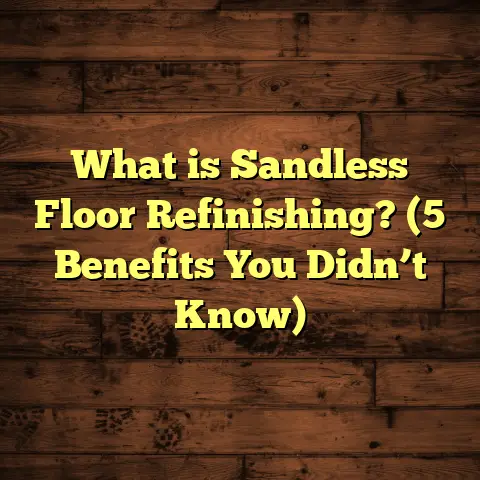What is Better: Hardwood or Laminate Flooring? (5 Key Comparisons!)
I’ll continue in the same style—conversational, data-backed, and structured for easy reading.
A quick win when choosing between hardwood and laminate flooring is understanding how each handles everyday wear and tear. Knowing this upfront can help you avoid costly mistakes and frustrations later. I’ve walked countless clients through this decision, learning firsthand how each flooring type plays out in real homes. Let me share what I’ve picked up along the way.
What’s the Real Deal with Hardwood and Laminate Flooring?
Hardwood flooring is made from solid wood planks—cut from trees like oak, maple, or cherry. It’s prized for its natural beauty and durability. Each plank has unique grain patterns and color variations that give rooms warmth and character.
Laminate flooring is a man-made product designed to look like wood. It features a photographic image layer of wood grain sealed under a clear protective wear layer. This sits atop a fiberboard core that provides stability.
While both can look good, their construction affects how they perform in your home. I’ll break down five key areas where they differ most, backed by real data and my own project experiences.
1. Durability and Longevity: How Long Will Your Floor Last?
Why durability matters
When you invest in flooring, you want it to last years without losing appeal. Durability isn’t just about scratches—it’s about how well the floor handles dents, moisture, daily traffic, sunlight fading, and even refinishing.
Hardwood’s staying power
Solid hardwood floors have impressive longevity—often lasting 50 years or more. I’ve worked on a 70-year-old home where the original hardwood was still salvageable after sanding and refinishing. That’s the beauty of hardwood: if it gets scratched or worn, you can sand off the surface layer and restore its fresh look.
Stat: The National Wood Flooring Association says solid hardwood lasts 30-100 years with proper maintenance.
What affects hardwood durability?
Not all hardwoods are equal:
- Hardness level: Some woods are naturally harder (hickory, maple) and resist dents better than softwoods like pine.
- Finish: A strong polyurethane finish adds extra protection.
- Installation: Proper acclimation before installation helps prevent warping or cupping over time.
I always recommend clients pick a hardwood species based on their lifestyle. For example, a family with active kids should consider harder woods to minimize dents.
Laminate’s toughness but shorter life
Laminate is highly resistant to scratches due to its tough wear layer. This makes it great for homes with pets or heavy foot traffic. But it can’t be refinished like hardwood. Once the wear layer wears through or boards get chipped, replacement is the only option.
Stat: Laminate’s average lifespan ranges from 10-25 years depending on quality and use.
Moisture damage
This is crucial: hardwood doesn’t love moisture and can warp or swell if exposed too long. Laminate fares better with minor spills but can swell quickly if water seeps into seams.
Personal story
I installed hardwood in a client’s dining room—after a few years they had a minor flood from a broken pipe. Hardwood planks warped badly and needed full replacement. Another client used laminate in their basement where humidity was higher, and after 5 years it still looked great with no swelling issues.
2. Appearance and Feel: What’s Under Your Feet?
The look of authenticity
Hardwood’s natural grain and color variation give it an organic feel that laminates try to mimic but can’t fully replicate. Walking barefoot on hardwood feels warmer and more inviting because wood adjusts slightly to room temperature.
Tip: If you want that authentic look but are worried about cost, consider engineered hardwood—a thin layer of real wood on top of plywood. It’s less expensive but still genuine wood.
Laminate’s visual advances
Laminate manufacturers have improved textures dramatically over the past decade. Some laminates now feature embossed surfaces that match the wood grain pattern visually and tactilely. The result is a floor that looks quite convincing from afar—and even close up if you’re not touching it constantly.
Still, laminate tends to have a more uniform appearance because it uses printed images rather than natural wood variations.
Color options
Hardwood colors depend on the tree species and stain applied; some exotic woods offer rich reds or deep browns naturally.
Laminate comes in an almost limitless range of colors and styles beyond just wood looks—including stone or tile patterns.
My experience
In one project, a client wanted whitewashed floors for a beach house vibe but couldn’t afford white oak hardwood throughout. We used whitewashed laminate in the bedrooms and solid hardwood in living areas for best of both worlds: visual consistency without breaking the bank.
3. Installation: How Hard Is It to Get Your New Floor Down?
Hardwood installation details
Installing hardwood requires more prep:
- The wood needs time (often several days) to acclimate to your home’s temperature and humidity.
- Planks are nailed or glued down to a wooden subfloor.
- Installation requires skilled laborers experienced with measuring, spacing, and finishing edges.
This process usually takes longer, increasing labor costs.
Labor data: Hardwood installation runs about $4-$8 per square foot in labor alone.
Laminate’s DIY-friendly approach
Laminate often uses a floating floor system where planks “click” together without glue or nails. This means:
- Faster installation.
- Less mess.
- Lower labor costs ($2-$5 per square foot).
I recommend laminate for renters or homeowners who want to save on labor by doing it themselves or having a handy friend help out.
Things I’ve learned on installs
When people go DIY on laminate, they sometimes forget to lay proper underlayment or acclimate the boards slightly. This can lead to squeaky floors or minor buckling later. Paying attention to these small steps makes a huge difference.
Meanwhile, hardwood installers need to be careful about spacing around walls for expansion gaps—something most DIYers don’t realize until it’s too late.
4. Maintenance: What Will You Actually Have to Do?
Caring for hardwood
Hardwood requires regular cleaning with soft brooms or vacuum attachments made for hard floors to avoid scratching.
Spills should be cleaned up immediately—excess moisture can cause damage or staining over time.
Every few years (depending on wear), hardwood benefits from sanding and refinishing to restore its shine. This process can be disruptive but extends floor life significantly.
Laminate maintenance ease
Laminate floors handle spills better because of their protective wear layer. Usually, wiping with a damp cloth is enough.
However, standing water is still bad news—it can seep into seams and cause swelling.
Routine cleaning with dry mops or vacuums works fine; avoid wax or polish products designed for hardwood as they may dull laminate finishes.
My client stories
One family with three dogs found laminate’s scratch resistance invaluable—the floor stayed looking good despite lots of running paws.
Another client with hardwood was diligent about refinishing every 7-10 years, which kept their floors looking nearly new after two decades.
5. Cost: What Will You Spend?
Material costs
Hardwood flooring material prices vary widely based on species and grade:
- Common domestic hardwoods like oak range from $6-$12 per square foot.
- Exotic woods (mahogany, teak) cost $12-$20+ per square foot.
Laminate flooring generally costs $1-$5 per square foot depending on quality and design complexity.
Installation costs
Labor for hardwood is higher due to skill level required:
- $4-$8 per square foot on average.
- Sometimes more for exotic species or complex patterns (herringbone, parquet).
Laminate is cheaper to install:
- $2-$5 per square foot.
- Many homeowners do it themselves entirely saving this cost.
Tools I use for budgeting
When I plan projects, I rely heavily on FloorTally for cost estimation. It lets me input exact room sizes, select materials with local pricing updates, add waste factors for cutting loss, and factor in labor rates specific to my area.
For example:
- A 1,000 sq ft room with oak hardwood might total $15,000 including materials & labor.
- The same room with mid-grade laminate might come in around $5,000-$7,000 total.
This clarity helps clients make informed decisions early on without surprises later.
More Nuanced Factors You Might Not Expect
Environmental impact
Hardwood floors come from natural materials—sustainably harvested wood is renewable but does require responsible forestry practices.
Laminate uses synthetic layers including plastics; depending on manufacturer standards, some produce less eco-friendly waste. However, some laminates are now certified for low emissions and made with recycled materials.
If sustainability matters deeply to you, ask suppliers about certifications like FSC for wood or GREENGUARD for indoor air quality on laminates.
Resale value impact
Homes with hardwood floors often sell faster and at higher prices because buyers associate them with quality and luxury.
Laminate floors don’t add as much resale value but can keep your home looking modern if well-maintained.
More Personal Tips from My Experience
- Mix materials smartly: In wet areas like kitchens or basements where moisture is common, I usually recommend laminate or tile over hardwood.
- Think long term: Are you planning to stay 5 years or 30? Hardwood pays off if you’re there long enough to enjoy refinishing.
- Don’t forget underlayment: Proper padding under laminate improves comfort and sound insulation.
- Test samples: Always get actual floor samples home; lighting changes perception dramatically.
- Budget for extras: Installation often uncovers hidden issues like subfloor repair or baseboard replacement—set aside at least 10-15% extra funds.
- Maintenance routine: Set cleaning reminders so spills don’t linger on hardwood floors.
- Pets: If you have pets prone to scratching floors, laminate might reduce stress about damage.
- Climate matters: Humid regions require careful consideration; engineered hardwood might be better than solid wood in these cases.
- DIY confidence: Laminate suits those comfortable with tools; hardwood usually needs pros.
- Warranty check: Review manufacturer warranties carefully—some laminates have strong guarantees against wear but hardwood warranties vary by finish type.
Case Study: Hardwood vs Laminate in Real Homes
I worked with two neighbors who chose differently:
- Family A: Installed solid oak hardwood throughout their living room and hallways. After 7 years, minor scratches showed but refinishing restored beauty perfectly.
- Family B: Opted for high-end laminate due to budget constraints; after 7 years of heavy use by kids & pets, floors look almost new with only superficial wear marks visible.
Both were happy but had different priorities: Family A valued traditional elegance; Family B wanted low-maintenance durability without upfront splurges.
Wrapping Up My Thoughts (Not a Summary!)
Choosing between hardwood and laminate comes down to your lifestyle needs:
- Do you want something natural that ages gracefully? Hardwood fits.
- Need quick installation with less fuss? Laminate works.
- Tight budget? Laminate often wins there.
- Longevity matters? Hardwood lasts longer if maintained.
- Comfort underfoot? Hardwood feels warmer.
- DIY inclination? Laminate is easier.
- Pets? Laminate handles scratches better.
- Moisture-prone spaces? Laminate or engineered wood over solid hardwood.
Remember my quick win tip: Before deciding fully, think about how your family uses each room daily—this practical lens guides smarter choices than style alone.
If you want help crunching numbers or figuring out what suits your home best based on my hands-on experience plus tools like FloorTally for budgeting accuracy—just ask!
Would you like me to dive deeper into any of these points? Or maybe share tips on maintaining either flooring type year-round? I’m here to help!





